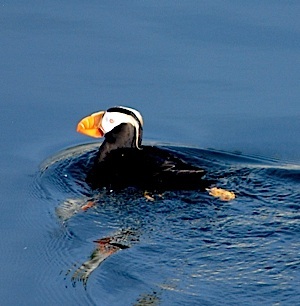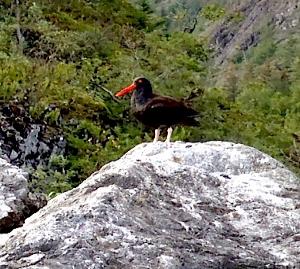I wasn't really sure what to expect from Glacier Bay National Park, outside of glaciers, of course. But it didn't take long to realize this Alaskan park is a birder's paradise. From the "poor man's puffin" to dwindling numbers of Kittlitz's murrelets, I was rewriting my birding success.
And not in days, but in minutes.
"Did you see all the young Glaucous-winged gull (Larus glaucescens) chicks?," park Ranger Linda Lieberman asked as we sat on the day-cruise ship Baranof Wind just off South Marble Island. "For those of you who want to see Common Murre (Uria aalge), the light is shining on them over here."
Not only were there Glacous-winged gulls and Common Murre -- an upright standing auk that, with its snow-white chest and belly, resembles a penquin -- but also Horned Puffins (Fratercula corniculata), Tufted Puffins (Fratercula cirrhata), Marbled murrelets (Brachyramphus marmoratus), an occasional Kittlitz's murrelet (Brachyramphus brevirostris), and Black-legged Kittiwakes (Rissa tridactyla).
And it wasn't even 10 a.m. yet.
Birds teem to Glacier Bay, thanks in no small part to its nutrient-rich waters -- and insect-filled skies and seed-bearing forests in summer and early fall -- along with its plentiful, and diverse, breeding habitat. Bird habitat in the park ranges from rocky slopes revealed in the not-too-distant past by receding glaciers to coastal rain forest and muskeg landscapes. In slender arms of the park's waters, such as in Dundas Bay, extreme tidal fluctuations help churn up and reveal meals for many species. And the fact that the Pacific flyway makes a beeline across the park doesn't hurt the overall species diversity, either.

Tufted puffins were easy to spot at South Marble Island. Kurt Repanshek photo.
There are an estimated 281 bird species in the park, and it seems like you see most of them on a day cruise from Bartlett Cove to South Marble Island 15 miles north and on towards Johns Hopkins and Tarr inlets, roughly 50 more miles (80.5 km) of water up bay.
The surrounding landscape makes it tought to stay focused on birding. Horizon-stretching isn't entirely an apt description, as from the deck of a boat the mountains seem to close in overhead, leaving a narrow patch of sky above. These are the sort of mountains you might pull from a Jack London novel or a passage from a James Michener or John McPhee book -- rugged and heavily treed, laced in the morning by threads of cloud, and roamed by brown bears, wolves, wolverines and mountain goats. As a result, you want to scan the shorelines not just for birds, but for goats on the cliffs and brown bears fishing for salmon or tumbling rocks to get at the critters that lie beneath.
And no matter where you're pointing your binoculars, once you hear the sharp report of ice calving from a glacier, you immediately look up to locate the new berg.
While terrestrial birders spend much of their time scanning trees, bushes, and even power lines for birds, in Glacier Bay you're looking down onto the water's surface to see what might be bobbing along at least as much as gazing overhead to see what might be wheeling over your boat.
South Marble Island arguably is the high point for day birders thanks to the rich variety of species to be spotted there. We spotted Common Murres and Pelagic Cormorants (Phalacrocorax pelagicus) clinging to the island's rocky cliffs, tried to freeze-frame puffins zipping by through the air, watched murrelets dive for snacks, and looked up at the Kittiwakes and Mew gulls circling the ship to get a closer look at these odd beings floating on the bay and staring at the island.
The Marbled murrelets were particularly vexing, as they bobbed calmly on the water's surface right up until the minute I aimed my camera at them. Then I was left with a swirl of water in my viewfinder as the birds had dived down and swam away with their strong wing-strokes.
But South Marble was far from the only place to go birding in Glacier Bay.
In August, bald eagles are readily visible, many with mottled fledglings in nests. During a short hike on Gloomy Knob we peered down into an abandoned nest that an eagle, perhaps confused, had built in the grass instead of in a tree. We could hear the sharp piping of a pair of eaglets in a more traditional nest, and a few moments later mom, or perhaps dad, came winging by on what we assumed was a lunch run.
Kayaking towards Margerie Glacier a little later during a week spent in the park we encountered Arctic Terns (Sterna paradisaea) and inqusitive Common Terns (Sterna hirundo), more Glaucous-winged gulls and Kittikwakes, and Pigeon Guillemots (Cepphus columba).

Black oystercatchers, with their carrot-shaped beaks, stand out against Glacier Bay's color schemes. Marcelle Shoop photo.
As the week went on we came upon what we could only figure to be a pair of Northern Harriers (Circus cyaneus) and some Black Oystercatchers (Haematopus bachmani) with their bright red, over-sized beaks seemingly guarding the mouth of Tidal Inlet.
Further on into the inlet we paddled towards hundreds of Black scoters (Melanitta nigra) -- also called the "poor man's puffin" by some for its somewhat colorful beak -- in a raft stretching halfway across the inlet. The next day we counted Green-winged Teal (Anas crecca), somewhat small (compared to the Canada version) Brant goose (Branta bernicla), and a Great Blue Heron (Ardea herodias) in Fingers Bay, while exploration of an arm of Dundas Bay the following morning produced more bald eagles.
As our trip was mostly on the water, we didn't get to wander deep into the forests that rim the bay and climb the mountains cupping its waters. But among the terrestrial birds that flit among those forests are pine siskins, redpoles, magpies, winter wrens, and ubiquitous chickadees. A Steller's jay raucously announced himself during a short foray we made into the muskeg forest off Dundas Bay.
A week is not enough time to come close to cataloging the park's birds through your binoculars. There are several varieties of warblers, common Robins, versions of plovers, ptarmigan, grosbeaks, grebes, loons, and phalaropes and that's just a short list of what we didn't see.
But a week in Glacier Bay is plenty of time to check off dozens of species on your life list.





